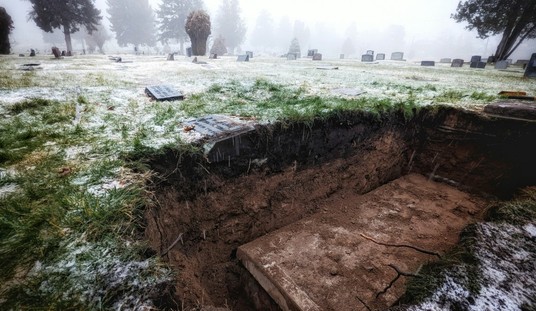There is virtually no one left on the planet that believes the Iran nuclear deal is anything other than a huge fraud designed to allow Iran to develop a nuclear weapon. The White House has basically stopped denying the substance of the deal. The AP is running a story on the secret annex to the agreement that requires the P5+1 to provide Iran with nuclear technology while Iran refuses to allow inspections or provide an accounting for its current and former facilities.
This would be the same deal the Senator Bob Corker succeeded in getting passed. So when that Iranian nuke arrives, you know who to thank.
Now that the utter uselessness of the agreement, the Obama administration has turned to their private propaganda organ POLITICO to convince us that if Iran does cheat, Obama stands ready to kick some mullah ass.
President Barack Obama’s nuclear diplomacy with Iran may yet fail. On Tuesday, exactly one week before a June 30 deadline for an agreement, Iran’s Supreme Leader delivered his latest in a series of defiant statements, setting conditions for a deal—including immediate relief from sanctions, before Iran has taken steps to limit its nuclear program—that Obama will never accept. Secretary of State John Kerry warned last week that the U.S. is prepared to walk away from the talks. And even if a deal is reached, the story is not over. The Iranians may break or cheat on an agreement, and try build a nuclear weapon anyway.
That’s why, at least three times in the past year, a B-2 stealth bomber has taken off from an Air Force base in Missouri and headed west to the White Sands Missile Range in New Mexico. For these missions, the $2 billion plane was outfitted with one of the world’s largest bombs. It is a cylinder of special high-performance steel, 20 feet long and weighing 15 tons. When dropped from an altitude likely above 20,000 feet, the bomb would have approached supersonic speed before striking a mock target in the desert, smashing through rock and burrowing deep into the ground before its 6,000 pounds of high explosives detonated with devastating force.
“It boggles the mind,” says one former Pentagon official who has watched video of the tests.
Those flights were, in effect, trial runs for the attack on Iran that President Barack Obama, or his successor, may order if diplomacy can’t prevent Iran from trying to build a nuclear weapon.Think of it as Plan B for Iran. The failure of diplomacy might lead the U.S. to turn to a weapon finally ready for real-word action after years of design and testing. The so-called “Massive Ordnance Penetrator,” or MOP, represents decades of military research, dramatically accelerated in recent years, focused on the problem of destroying targets buried deep underground.
This is just empty posturing of the most dangerous sort. It isn’t a description of a diplomatic strategy or a military option. It is purely fanciful.
The salient point to remember is that no one in the West knows the location of all Iranian nuclear facilities. The administration is waving at the Fordow facility but it is the one we know about. Keep in mind that the Fordow facility was only discovered in 2009 even though construction was eventually revealed to have begun in 2007. Even so, it is a formidable target. We believe, underscore believe, it is located at least 260 feet beneath a mountain and is constructed of highly reinforced concrete. In Crowley’s apologia for Obama’s diplomatic malfeasance he discusses the capabilities of the new earth penetrator.
The Boeing-designed and produced MOP weighs six times more than the GBU-28, and about 15 times more than that bomb’s predecessor. According to published reports, the MOP can burrow through 200 feet of earth and 60 feet of concrete before its blast destroys whatever it finds there.
As recently as 2012, however, even the MOP lacked the clout to take out Fordow, officials concede. Since then it has undergone repeated upgrades to remedy glitches. The Air Force’s B-2 fleet was upgraded, at a cost of nearly $100 million, to carry the bomb—but two 2013 test flights were aborted after faulty wiring prevented the planes from dropping the MOP. In the past several months, even as Obama’s nuclear diplomacy with Iran advanced, the MOP underwent further upgrades and refinements. Its fuse has been upgraded to ensure it can withstand the bomb’s initial impact with the earth, and its satellite guidance systems refined for more precise targeting. According to unnamed officials cited by the Wall Street Journal in April, the MOP has also been outfitted with countermeasures against Iranian jammers that might try to throw off its GPS system.
Note that even the experts don’t believe it will work:
Not everyone is certain about that. “Can you take out Fordow with this ordnance? I doubt it,” says Anthony Cordesman, a military analyst at the Center for Strategic and International Studies. Cordesman notes that it’s hard to know how vulnerable an underground site may be, and that while some turn out to be flimsier than expected, the opposite is often true. Cordesman does believe, however, strikes targeted against its entrances could disable the facility for a substantial time. “Can you shut it down?” Cordesman asks. “Yeah.”
That’s a temporary solution. Entrances can be cleared and rebuilt. Replacing centrifuges and their nuclear material takes longer. Any president who risks an attack on Iran may insist on inflicting more damage than a few bulldozers can undo.
There are several problems in this latest bit of talk tough nonsense emanating from the White House.
First and foremost is the problem of target acquisition. The Fordow facility had been completely built and was being equipped to handle centrifuges when it was discovered. The construction process was admitted by the Iranians to have started in 2007, though there is no way of verifying that. Fordow is not located in some remote corner of Iran. It is located 12 miles from the city of Qom (population: 1.1 million). Essentially it is in the suburbs of that major metropolis. This speaks to the difficulty in identifying Iran’s nuclear facilities.
Second. Targeting is difficult. Back to POLITICO for more smoke and mirrors:
Like doctors relying on X-rays and MRIs, cave hunters must rely on high-tech equipment that can, in effect, see through solid objects—or sense things like seismic disturbances. That can involve exotic-sounding devices like geophones, laser vibrometers and drones equipped with gravimeters—devices that sniff for gravitational disturbances which suggest an underground cavity. (The U.S. has never explained the mission of an unarmed U.S. drone that crashed in Iran in 2011.)
They also rely on more traditional means, including satellite imagery from the National Geospatial-Intelligence Agency (NGA). That can reveal, say, a new transportation route that suspiciously dead-ends at a mountainside. Analysts also hunt for so-called “effluents,” like liquid waste. Exhaust vents aren’t just a tell, but can also be a vulnerability: Long calls this the “Death Star problem” facing any bunker-builder, a reference to the air shaft that allowed Luke Skywalker to destroy Darth Vader’s massive space station with a single well-placed shot.Hunched over computers in a commercial building near the Pentagon, UFAC workers analyze suspect sites and determine what it would take to blow them up. That could involve analyzing the soil and rock under which it is buried, its depth, the thickness of its walls and the materials used to reinforce them. Their conclusions are uploaded into targeting databases, including one code-named GEMINI, that are used by military planners worldwide. In the event of an attack, the UFAC, relying heavily on NGA imagery, would also analyze the damage and determine whether follow-up strikes were necessary.
No one really knows the actual layout of the facility. For that matter we don’t even know if the level that has been admitted to is the only level.
Third. With a conventional earth penetrator your capability is governed by some pretty simple physics: hardness of the penetrator, density of the target, depth of target, and altitude of release. You will note in the description of the weapon that, under best case scenarios the revealed Fordow facility is already at the outside limits of capabilities.
Fourth. While an earth penetrator is constrained by physics, facility construction is pretty easy.
Heavily mountainous Iran has a long history of tunneling toward civilian as well as military ends, and Mahmoud Ahmadinejad has played a recurring role — first as a transportation engineer and founder of the Iranian Tunneling Association and now as the nation’s president.
There are hundreds, perhaps thousands, of big tunnels in Iran, according to American government and private experts, and the lines separating their uses can be fuzzy. Companies owned by the Islamic Revolutionary Guards Corps of Iran, for example, build civilian as well as military tunnels.
No one in the West knows how much, or exactly what part, of Iran’s nuclear program lies hidden. Still, evidence of the downward atomic push is clear to the inquisitive.
Google Earth, for instance, shows that the original hub of the nuclear complex at Isfahan consists of scores of easily observed — and easy to attack — buildings. But government analysts say that in recent years Iran has honeycombed the nearby mountains with tunnels. Satellite photos show six entrances.
Iran is in possession of several tunnel boring machines.
These massive “drills”, some as much as 50-feet in diameter, can drill hard rock tunnels at a rate of about 40 yards per day. So not only do we not know where the facilities are to target, even if we did know the Iranians have the technology today to defeat any conceivable earth penetrator by simply going deeper.
An unnamed administration source, who probably desired to remain nameless so as to not be associate with the nonsense he’s paid to spout, offers this assessment:
Even if the MOP never touches Iranian soil, it will have played a vital function. Iran might not have come to the bargaining table without a credible threat to destroy its program. “Having the option and getting word of it out there reminds the Iranians that their program is at risk,” says the former Pentagon official. “That gives us leverage over them.”
“Even in the aftermath of a deal,” adds the official, “it creates a strong deterrent so the Iranians abide by the deal,” the official says.
It may be that Iran is too intimidated by the MOP to crank up enrichment at Fordow in the sight of international inspectors. But after any deal, the UFAC will scour Iran for any hint of the next Fordow.
This is simply false given the information in the story. We don’t have a penetrator that can take out Fordow. Iran knows that. We don’t know the scope of their facilities. Iran knows that. Iran is currently in breach of the deal. Everyone knows that. It has been covered by Bloomberg, AP, the Wall Street Journal, and others. There is no deterrence because we don’t know where to strike and because Iranian tunnel technology is more robust than our ability to abrogate the laws of physics.
It is shameful that POLITICO would stoop to this craven and brazen level of covering for the White House. No vaguely cognizant person believes Obama is going to war over Iran cheating on an agreement that he knows they are cheating on right now. By the time his successor sorts things out, an Iranian nuke will be mounted on a North Korean missile and the only war possible will be nuclear.













Join the conversation as a VIP Member